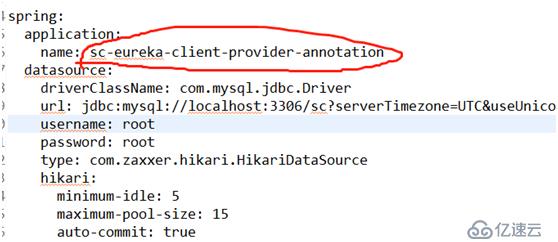公众号:java乐园
1、上一篇学习了服务提供者provider,但是并不是单单就学习了服务提供者。中间还穿插使用了Hikari数据源和spring cloud整合mybatis。但是上篇使用mybatis时还是沿用了老的方式,需要配置mapper对应的xml文件。先来看看上篇使用mybatis的主要步骤
一、 pom.xml文件引用
<dependency>
<groupId>org.mybatis</groupId>
<artifactId>mybatis-spring</artifactId>
<version>1.3.2</version>
</dependency>
<dependency>
<groupId>org.mybatis.spring.boot</groupId>
<artifactId>mybatis-spring-boot-starter</artifactId>
<version>1.3.2</version>
</dependency>二、 application.yml配置文件加入mybtias配置项
mybatis:
mapperLocations: classpath:sc/provider/dao/*.xml
#configLocation: classpath:mybatis-config.xml三、 编写mapper文件user-mapper.xml
<?xml version="1.0" encoding="UTF-8" ?>
<!DOCTYPE mapper PUBLIC "-//mybatis.org//DTD Mapper 3.0//EN" "http://mybatis.org/dtd/mybatis-3-mapper.dtd" >
<mapper namespace="sc.provider.dao.UserDao" >
<select id="getUser" parameterType="java.lang.Long" resultType="sc.provider.model.User">
select id, userName, age, position from t_user where id = #{id,jdbcType=INTEGER}
</select>
<select id="listUser" resultType="sc.provider.model.User">
select id, userName, age, position from t_user
</select>
<insert id="addUser" parameterType="sc.provider.model.User">
insert into t_user (
id, userName, age, position
) values (
#{id,jdbcType=INTEGER},
#{userName,jdbcType=VARCHAR},
#{age,jdbcType=INTEGER},
#{position,jdbcType=VARCHAR}
)
</insert>
<update id="updateUser" parameterType="sc.provider.model.User">
update t_user set
userName = #{userName,jdbcType=VARCHAR},
age = #{age,jdbcType=INTEGER},
position = #{position,jdbcType=VARCHAR}
where id = #{id,jdbcType=INTEGER}
</update>
<delete id="deleteUser" parameterType="java.lang.Long">
delete from t_user
where id = #{id,jdbcType=INTEGER}
</delete>
</mapper>四、 编写UserDao.java
package sc.provider.dao;
import java.util.List;
import sc.provider.model.User;
public interface UserDao {
User getUser(Long id);
List<User> listUser();
int addUser(User user);
int updateUser(User user);
int deleteUser(Long id);
}五、 在ProviderApplication.java添加
@MapperScan(basePackages="sc.provider.dao")经过上面五个步骤才能使用mybatis。本篇将和大家看看不能简化spring cloud 整合mybatis的步骤(在sc-eureka-client-provider工程上改造)
一、 依赖必不可少
<dependency>
<groupId>org.mybatis</groupId>
<artifactId>mybatis-spring</artifactId>
<version>1.3.2</version>
</dependency>
<dependency>
<groupId>org.mybatis.spring.boot</groupId>
<artifactId>mybatis-spring-boot-starter</artifactId>
<version>1.3.2</version>
</dependency>二、 删除application.yml关于mybatis的配置
三、 删除mapper文件user-mapper.xml文件
四、 改造UserDao.java类
package sc.provider.dao;
import java.util.List;
import org.apache.ibatis.annotations.Delete;
import org.apache.ibatis.annotations.Insert;
import org.apache.ibatis.annotations.Mapper;
import org.apache.ibatis.annotations.Select;
import org.apache.ibatis.annotations.Update;
import sc.provider.model.User;
@Mapper
public interface UserDao {
@Select(value="select id, userName, age, position from t_user where id = #{id,jdbcType=INTEGER}")
User getUser(Long id);
@Select(value="select id, userName, age, position from t_user")
List<User> listUser();
@Insert(value="insert into t_user (id, userName, age, position) values ( #{id,jdbcType=INTEGER},#{userName,jdbcType=VARCHAR},#{age,jdbcType=INTEGER},#{position,jdbcType=VARCHAR})")
int addUser(User user);
@Update(value="update t_user set userName = #{userName,jdbcType=VARCHAR},age = #{age,jdbcType=INTEGER},position = #{position,jdbcType=VARCHAR} where id = #{id,jdbcType=INTEGER}")
int updateUser(User user);
@Delete(value=" delete from t_user where id = #{id,jdbcType=INTEGER}")
int deleteUser(Long id);
}五、 @MapperScan注解必不可少
package sc.provider;
import org.mybatis.spring.annotation.MapperScan;
import org.springframework.boot.SpringApplication;
import org.springframework.boot.autoconfigure.SpringBootApplication;
import org.springframework.cloud.netflix.eureka.EnableEurekaClient;
@SpringBootApplication
@EnableEurekaClient
@MapperScan(basePackages="sc.provider.dao")
public class ProviderApplication {
public static void main(String[] args) {
SpringApplication.run(ProviderApplication.class, args);
}
}经过以上步骤就把使用xml方式的mybatis改造成使用annotation方式的mybatis了。
2、启动注册中心sc-eureka-server,启动sc-eureka-client-provider-annotation(使用sc-eureka-client-provider项目改造),验证是否改造成功
方式一:
方式二:

圈住的名字是在application.yml配置的

3、使用postman方法相应restful接口,这里就不一一访问了,可以参考上一篇文章的访问方式
添加:
http://127.0.0.1:8300/user/addUser
查询:
http://127.0.0.1:8300/user/getUser/4
列表:
http://127.0.0.1:8300/user/listUser
更新:
http://127.0.0.1:8300/user/updateUser
删除:
http://127.0.0.1:8300/user/deleteUser/2
亿速云「云服务器」,即开即用、新一代英特尔至强铂金CPU、三副本存储NVMe SSD云盘,价格低至29元/月。点击查看>>
免责声明:本站发布的内容(图片、视频和文字)以原创、转载和分享为主,文章观点不代表本网站立场,如果涉及侵权请联系站长邮箱:is@yisu.com进行举报,并提供相关证据,一经查实,将立刻删除涉嫌侵权内容。